You're ready to take your business to the next level. You've heard the buzz about referral programs, and seen competitors reaping the benefits, but where do you even begin? The concept seems simple: leverage your existing customers to bring in new ones. But the execution? That's where things get murky.
Navigating the world of referral programs can feel like venturing into uncharted territory. Questions swirl around: What exactly is a referral program? How do you set one up? How do you track success? And perhaps the most daunting question of all — how can you ensure your customers actually participate?
If this sounds like you, rest assured, you're not alone. Many businesses find themselves at this crossroads, eager to harness the power of referral programs but unsure how to navigate the process.
This article is here to serve as your compass, guiding you through the ins and outs of creating a successful referral program that not only attracts new customers but also rewards those loyal ones who help you grow. Let's dive in and demystify referral programs together.
Growth stands at the heart of business success. It opens doors to new markets and fortifies a company's resilience. Yet, achieving sustainable growth remains a perennial challenge for many businesses.
Enter referral programs, a strategic solution to spur growth by tapping into your most valuable asset: your satisfied customers.
A referral program is your business's game plan for turning satisfied customers into your personal sales force. These programs incentivize your current clientele to act as brand ambassadors.
They share their positive experiences, thus drawing in new patrons. These customers already love what you do; now you give them the tools to share that love – and get rewarded for it.
Think of it as a give-and-get scenario.
Your customer shares a unique referral link with friends. This isn't just any link; each one is the digital equivalent of a personalized handshake between the referrer and the referred, coded with the power to track who sent who.
When a friend bites, signs up, or makes a purchase, boom – your original customer gets a perk. It could be a discount, a service upgrade, cool merchandise, or even cold hard cash.
Imagine this as your digital word-of-mouth engine, revving up without you lifting a finger.
It's seamless. You just need the right software to track those referrals and make sure everyone gets their due rewards. Keep the rules simple, make the rewards sweet, and watch your business grow organically.
Referral marketing spans the horizon of tactics that stimulate customers to talk about your brand. It's the strategy of spreading your business ethos via word-of-mouth, but turbocharged. It leverages networks, relationships, and every shoutout opportunity, virtual or face-to-face.
Referral programs slice right into the core of this tactic. Consider them a specialized, measured approach within your broader referral marketing strategy.
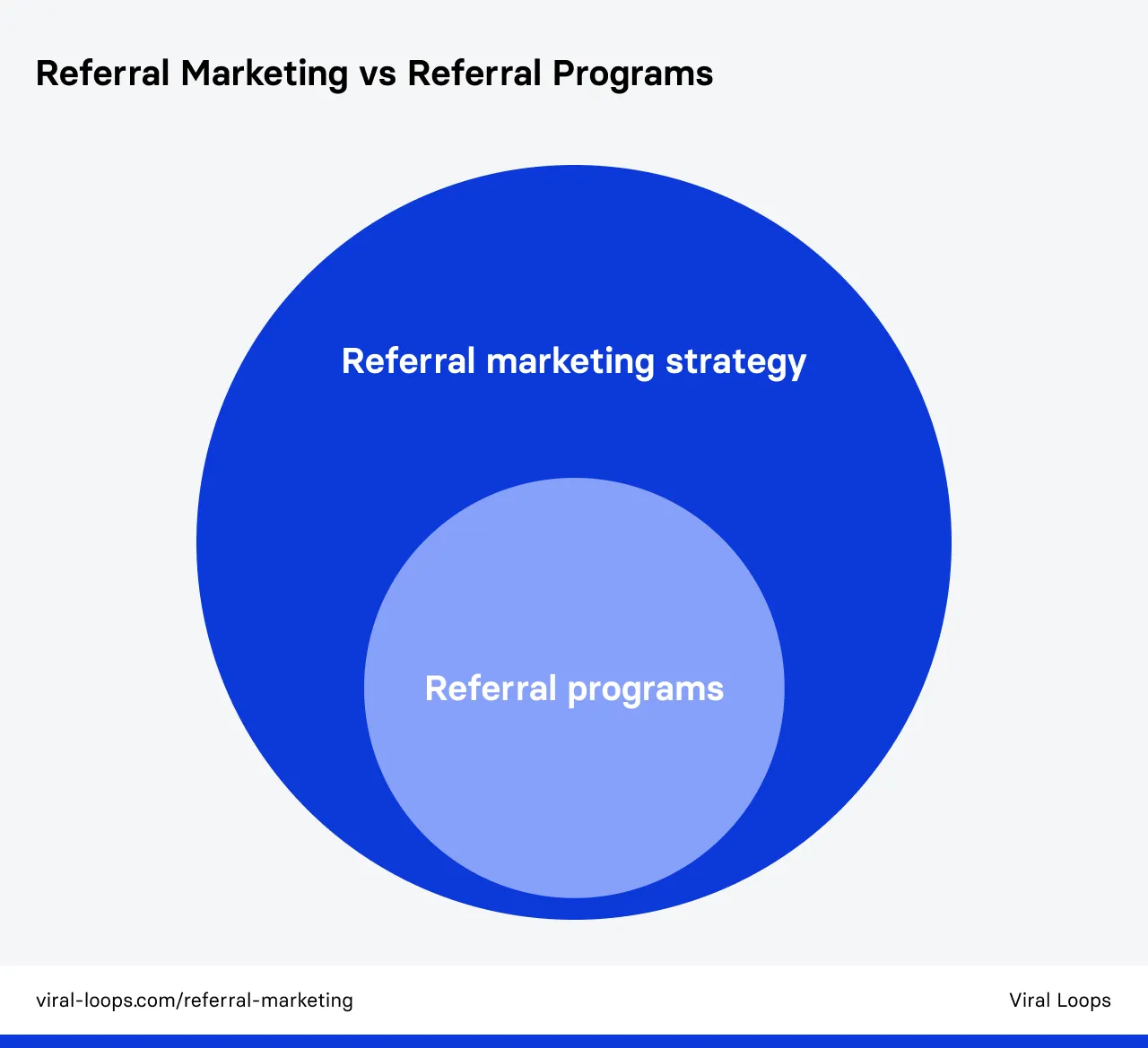
They come with structure, goals, and compensation models—all designed with precision. You're not just asking for a shoutout; you're engineering an environment that rewards it.
So, while referral marketing is the ecosystem, referral programs are species within it, functioning with their own rulesets. It's symbiosis versus solo acts. Both are vital, yet moving to different rhythms.
Referral programs fuel business growth by transforming customer satisfaction into a powerful marketing force. Here’s how they do it:
It's a prime growth engine for one simple reason: people trust their friends.
This trust transfers onto your brand when a friend recommends it. So when you notch a referral, that new lead is already warmed up for you. They come with a level of trust that cold leads can't match.
In fact, people are 90% more likely to trust and make a purchase from a brand when either family or friends tell them about it. That's powerful.
If you love stats like we do, check out these 50 Referral Marketing Statistics That Prove Its Power.
Now imagine tapping into this potential across your customer base. That's what referral programs do. They are cost-effective because those marketing dollars directly correlate to new customers.
Customers who refer others actually stay longer with your brand. They're invested—not just in what they get out of it, but in the success of their referrals.
It becomes a cycle that feeds itself: happy customers stay, and refer more, which in turn grows your base even further.
No ad can match the authenticity of a friend's endorsement. What's more, up to 50% of all purchasing decisions are influenced by word-of-mouth. This means referral programs aren't just a tactic; they're a strategic must-have.
The leads you get here? They're high-quality. They convert better, close faster, and have a higher lifetime value.
And since your existing customers know what type of people would benefit from your product or service, they're likely to refer others who are a good fit for your business.
To summarize, referral programs empower your customers, reward them, and weave a network of trust and loyalty around your brand. Your growth becomes organic, driven by the very people who know and love what you offer.
For a referral program to thrive, it necessitates the inclusion of multiple components. Overlook just one, and you risk missing out on crucial aspects. Let's discuss each one:
Your referral program shouldn't just exist; it should have clear-cut goals. Think expansion with precision.
You want more eyeballs? Aim for engagement that translates to conversions.
Seeking higher retention? Craft incentives that keep your clientele coming back for more.
In short, you need to have a clear definition of what you want to achieve with your referral program. If you don’t have a goal and this is just an afterthought for you, expect that you won’t get much from it.
Now, onto the nuts and bolts.
In the digital age, referrals are gold, but you've got to refine them with the right tech. You can't track what you don't measure, so get yourself a solid platform that does the heavy lifting.
Whether it's a bespoke solution or a SaaS titan, make sure your tool can scale with you. Your toolkit should have a referral tracking system in place, a user-friendly interface, and analytics that make sense of behavior patterns, like Viral Loops.
Read our article on 11 Referral Marketing Software to Boost Sales (for Marketers) to get acquainted with the best ones in the market.
The goal is to keep it seamless for the users, and rich in data for you. Think smart, grow smart.
Developing your referral program isn't just a creative endeavor, it's a strategic pivot point for your business. Nail this, and you turn your happiest customers into your top salespeople.
Here are some tips on how to approach this:
A clear and compelling offer sits at the heart of any referral program. Nail this, and you're golden. Your offer should scream value and resonate with your audience's desires. When creating this, go back to your goals to make sure they align.
Forget complex schemes — simplicity wins.
Your customers want to know exactly what's in it for them, no riddles attached. Make your offer too good to overlook and easy to understand.
This clear value proposition becomes the pulse of your program. It's what turns a happy customer into an active advocate. Go vague, and you risk ambiguity, reducing the chance of your program being a conversation starter.
You need to hook your customers with real value. Maybe it's exclusive access, a discount, or a feature unlock — the bait matters. Nail the incentive, and you've got their attention.
But what if you don’t want this to be a one-time deal?
What if you want your customers to keep referring people they know? If the rewards are the same over and over, chances are they’ll get tired of receiving the same old thing.
That's where tiered rewards come in, making every referral a step up in your community. With tiered rewards, your referrers get bigger and better incentives the more new customers they refer.
You can even make it more exciting by gamifying the referral system. For more examples, check out Referral Marketing Ideas here.
Strike a balance between enticing for the referrer and sustainable for you.
A great offer answers "What's in it for me?" with clarity and impact. When your customers believe in the reward, they share it—not as an afterthought, but as a highlight of their day. This is where your program shifts from just existing to thriving.
However, it should also be cost-effective for you. After all, rewards (even discounts) come at your expense. You can actually adjust the rewards as you go along, so make sure you keep monitoring your stats and evaluating the return on investment.
You're crafting the rulebook now. Terms and conditions set the tone for your referral program. They're the fine print that keeps everything fair and square.
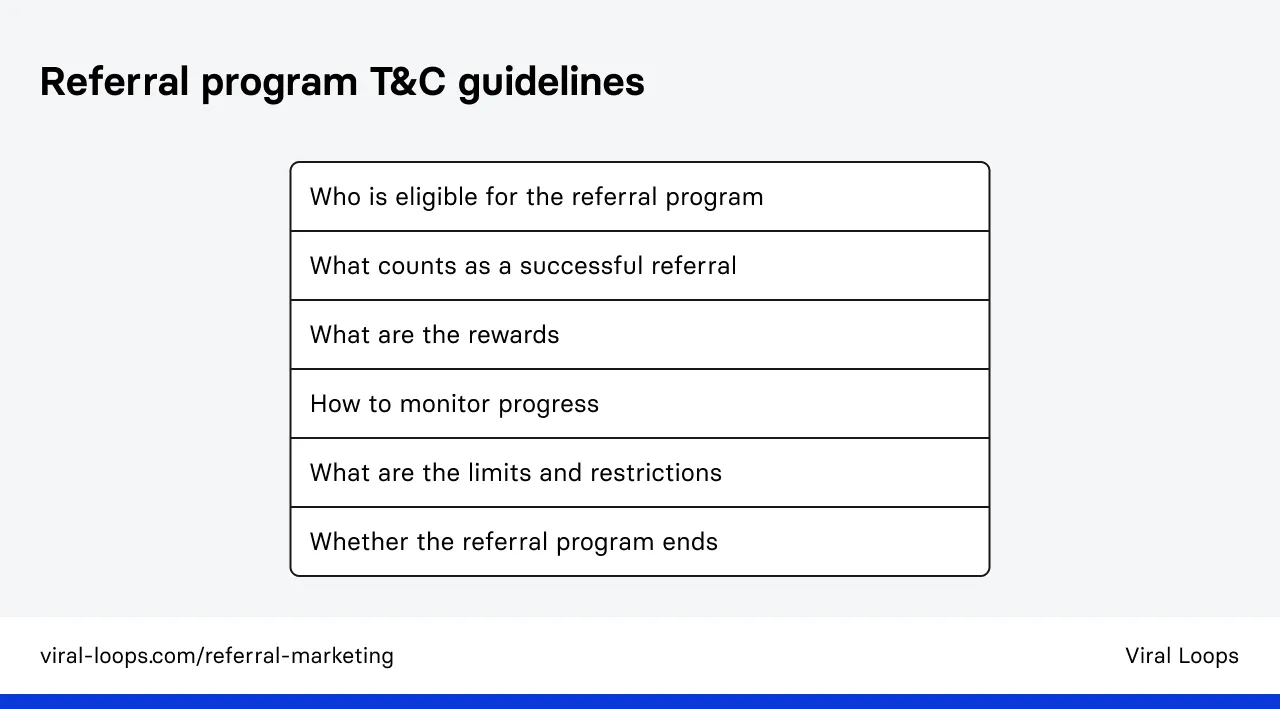
Who can participate in your program? It is important to make the criteria broad enough to include as many individuals as possible, without diluting the value of the program.
You'd want to ensure that you provide opportunities to a wide range of people who can benefit from the program's offerings. By casting a wider net, you can foster diversity and inclusivity, creating a vibrant and enriching experience for all participants.
But of course, it should still be narrow enough so that only referrals that are worth it are rewarded.
Is it a purchase or a subscription? It's important to be specific and leave no room for guesswork. Your customers should have clear instructions on the exact action their referrals need to take.
By providing these specific details, you can ensure a seamless and straightforward referral process for your customers. It also sets their expectations on how involved they should be in the referral process to ensure a reward.
To ensure that everyone is on the same page and to avoid any confusion about when they will receive their rewards, it is important to clearly spell out what they will get and when they can expect to receive it.
Providing specific details and timelines not only helps manage expectations but also builds trust and transparency in the process.
Pro Tip: Deliver the reward as fast as you can. The quicker you give them the reward, the more encouraged they'll be to keep referring other people.
Ensure your referrers have a seamless way to track the journey from share to successful referral. The tools you provide will serve as a constant reminder of their contributions to your expanding network.
It's simple: people love to see the fruits of their labor. Let them see it, and let them savor it.
A dashboard, a stats page, or real-time notifications—these empower your referrers to track progress and see tangible results.
You can send an email when a referral converts. Better yet, implement a dedicated section in their account for tracking referral status. You should prioritize visibility because when your referrers see their impact, they're motivated to keep sharing.
By setting caps to prevent exploitation, you can maintain a fair and balanced system. For instance, you might want to consider allowing only a specific number of referrals per person to ensure equal opportunities for everyone involved.
When it comes to rewards, setting expiration dates can be a powerful strategy. By establishing a specific timeframe within which rewards can be claimed, you create a sense of urgency and encourage prompt action.
This can help motivate individuals to take advantage of the rewards and benefits offered, maximizing their value. Moreover, expiration dates can also serve as a way to manage inventory or availability, ensuring that resources are allocated efficiently.
When explaining the terms and conditions of your rewards program to business folks, it's crucial to keep it concise and avoid unnecessary fluff. Use plain language that is easy to understand, without overwhelming them with technical jargon.
You can even provide a summarized version with a link to a more technical version. This will ensure that customers are not turned away and can fully grasp the details of the referral program.
When drafting the terms and conditions of referral programs, it is crucial to create comprehensive guidelines that protect your interests. These guidelines should be clear and unambiguous to prevent any misinterpretations.
By providing detailed context and outlining the expectations and rewards of the referral program, you can ensure transparency and encourage maximum engagement from your customers.
Make sure you align your referral programs tightly with your brand's core values. This synergy matters. Consistency here reinforces trust and recognition.
What's your brand's story? Anchor your referral program in that narrative. Let that story drive your messages, incentives, and experiences.
Create rewards that you are sure your referrers will benefit from.
Points and cash rewards sometimes work, but what works best is something you are certain your current customers can make use of, like the actual products they buy from you!
For instance, Pottycats sells cat litter and litter boxes, so they opted to give out cat litter for every valid referral.
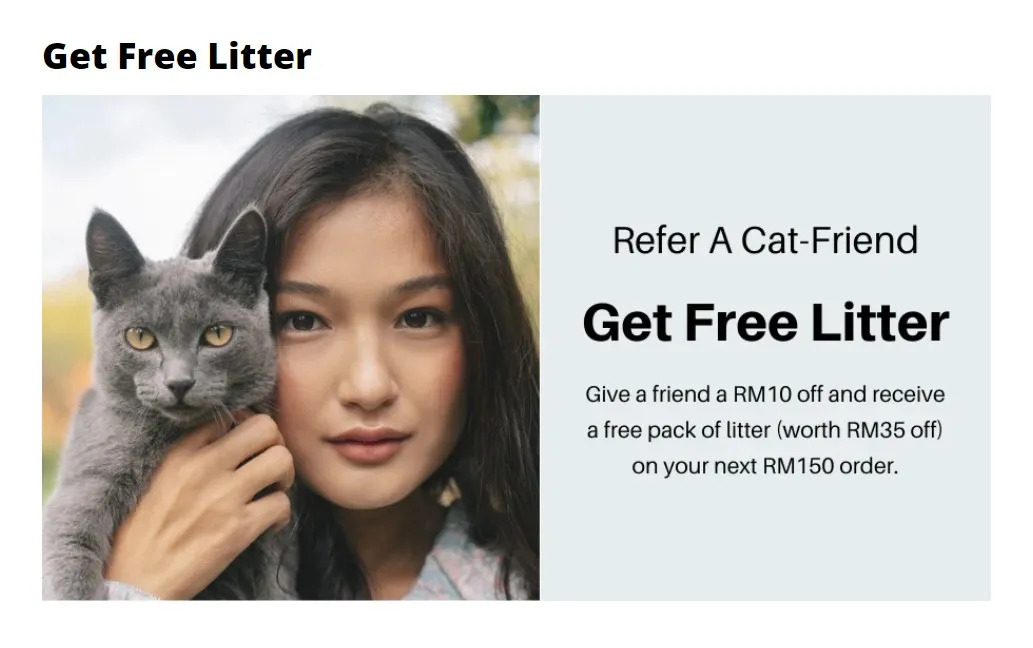
You won’t have to look too far or think too hard when it comes to making sure your rewards and your brand align. You just need to be creative in your presentation.
Does your business champion sustainability? Reward referrals with eco-friendly perks. Are you all about innovation? Offer early access to new tech. Incentives must feel like a natural extension of what you stand for.
When you talk about your referral program, use the same tone and language you'd use with any other service or product offering.
One great example is Crap Eyewear, with its referral program tagline of “Share the CRAPPINESS :)”
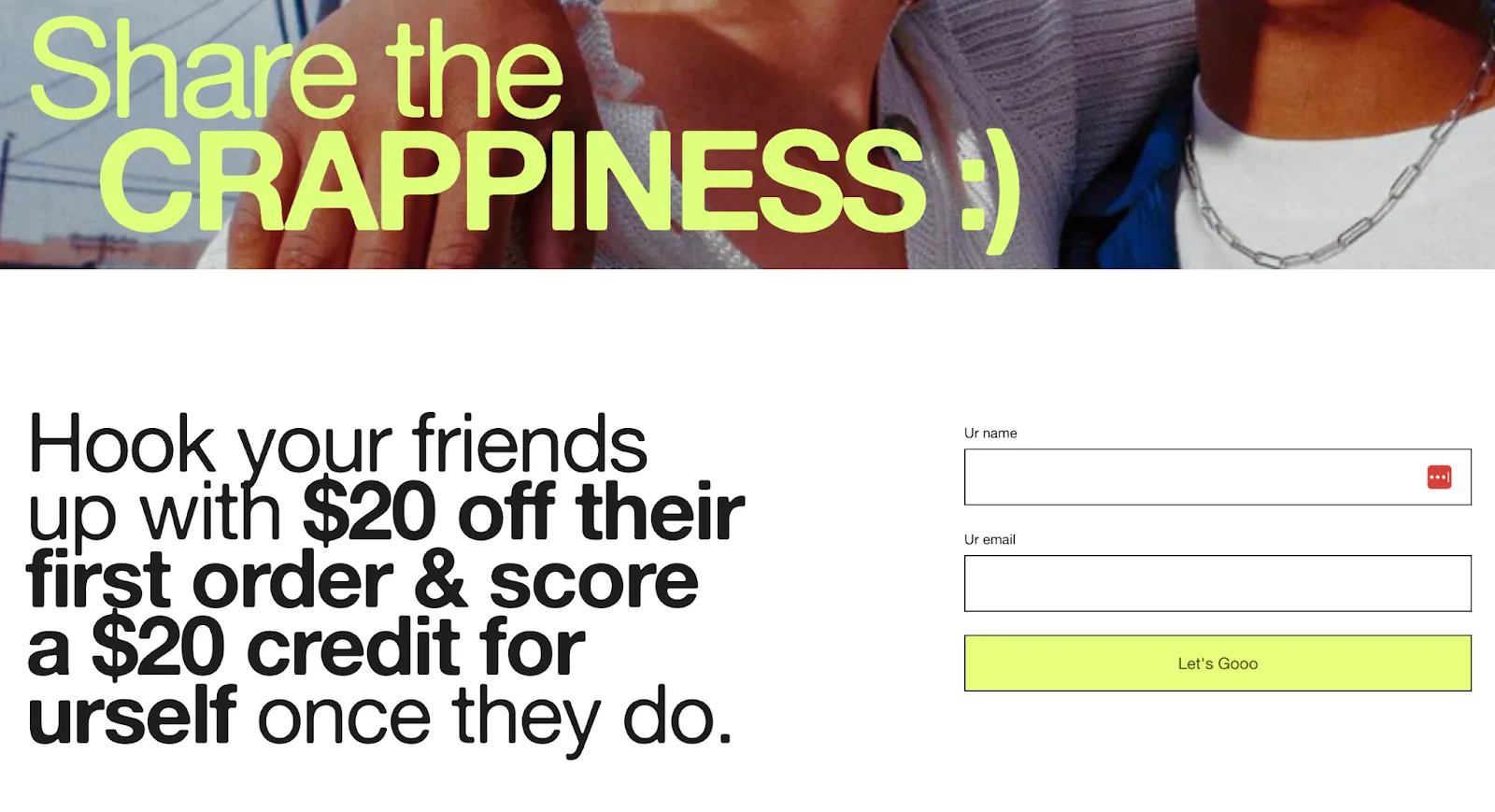
It works because it's in line with their casual and playful brand persona.
Stay genuine; people can tell when you don't.
Success stories resonate, so share tales of successful referrals.
This not only increases credibility but also emotionally connects with potential referrers. Let your customers know that behind every referral, there's a narrative worth sharing.
Visual consistency is key. Ensure your referral program promotional materials match your business’s overall style and color palette. From your website to the referral emails, make every touchpoint unmistakably yours.
Remember, swift integration speaks volumes. It tells your customers that the referral program is a core aspect of your brand, not an afterthought. Keep it simple. Keep it consistent. That's how your referral program becomes second nature to your customers—and to your brand's identity.
Referral programs can be a powerful tool for business growth, but they're only as effective as your customers' understanding and engagement with them.
The first step towards making your referral program work is letting your customers know about it. This involves explaining what a referral program is, how it works, and what benefits it brings to them.
Also, be open to making adjustment to your program as you go along. Listen to what your customers have to say, while at the same time, evaluating the stats to see if it’s working as designed.
A well-executed referral program can significantly boost your business growth. However, certain mistakes can undermine its effectiveness.
Here are some common pitfalls you should avoid:
The theory's fine, but show me the money, right? Here are some examples that may inspire to take the leap today:
Revolut, a leading fintech company, has leveraged the power of referral marketing to drive user acquisition, promote new features, and launch successfully in new markets. Their referral marketing strategies led them to grow 150 times.
The company utilized 5 kinds of referral campaigns to grow its customer base via its existing high-quality customers, increase the adoption rate of new features, and launching in new markets.
This is a great example of how continuous improvement can get you better results in the long run.
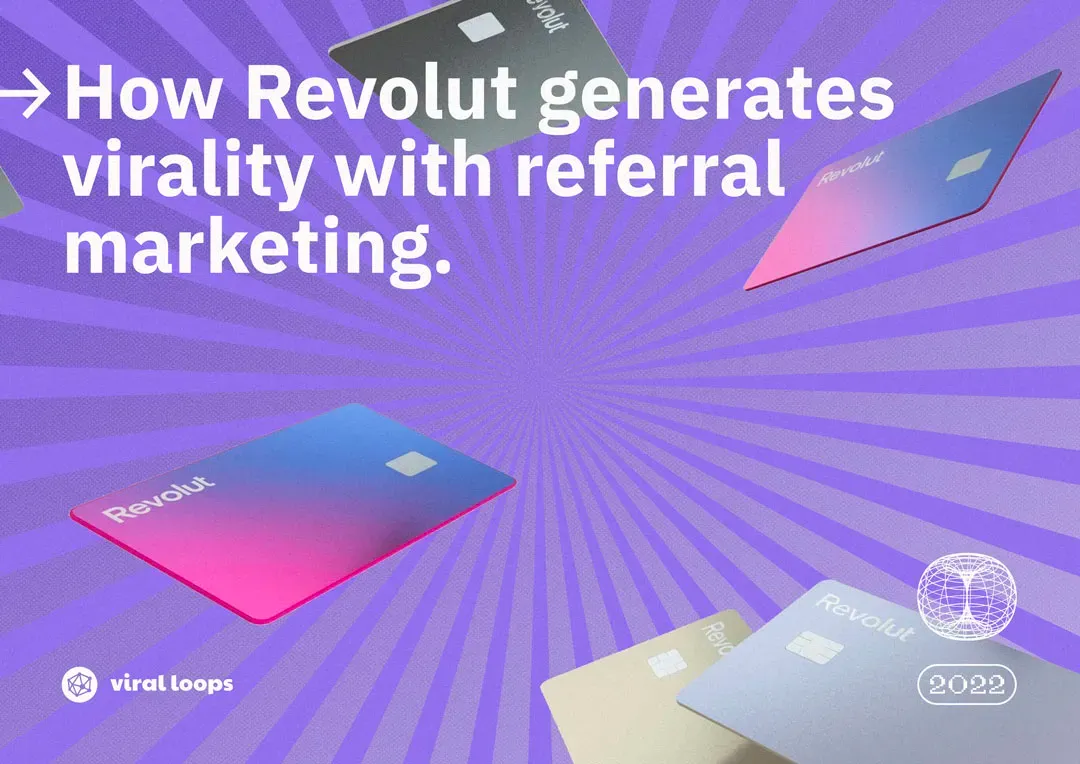
Read the full Revolut case study here.
PayPal's referral program is a remarkable example of how a well-crafted incentive scheme can fuel a company's growth. The program was instrumental in helping PayPal reach an astonishing 10% growth every single day!
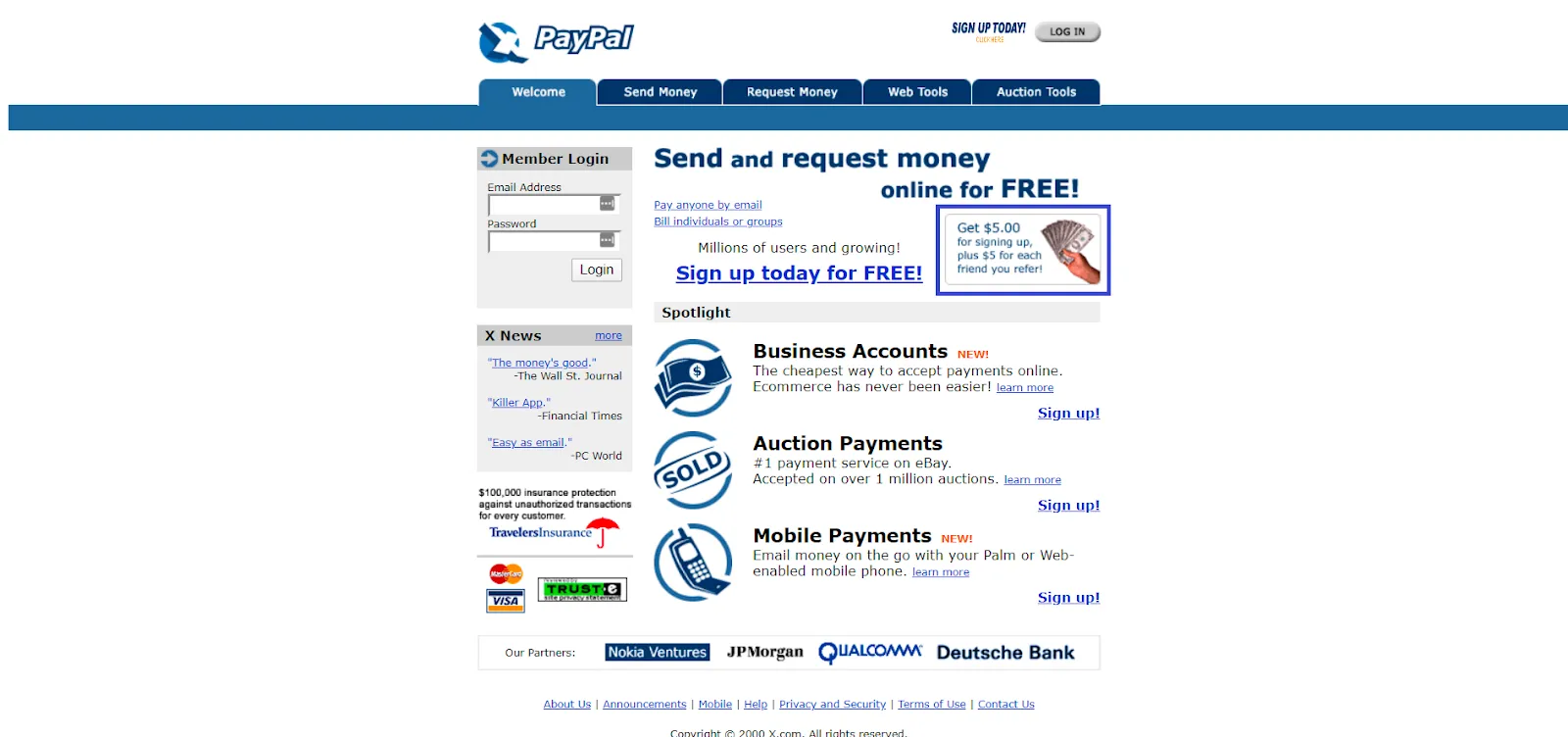
Initially, PayPal offered a double-sided reward that gave $20 to anyone who opened a PayPal account and an additional $20 for referring another user. This strategy resulted in a viral growth rate of 7 to 10% daily.
Over time, as the user base grew, the reward was reduced first to $10, then to $5 per signup or referral. Despite the reduction, the referral program continued to drive user acquisition, demonstrating the power of a well-structured referral system.
The success of PayPal's referral program inspired other companies, such as Dropbox, to implement similar strategies. The key takeaway from PayPal's referral program is that the rewards should align with the product offering and encourage users to engage with the product, not just incentivize them to join.
Read Paypal's case study in full.
Dropbox's referral program is an extraordinary example of a simple yet effective growth strategy. This program was pivotal in driving Dropbox's exceptional growth of 3900% in its early days.
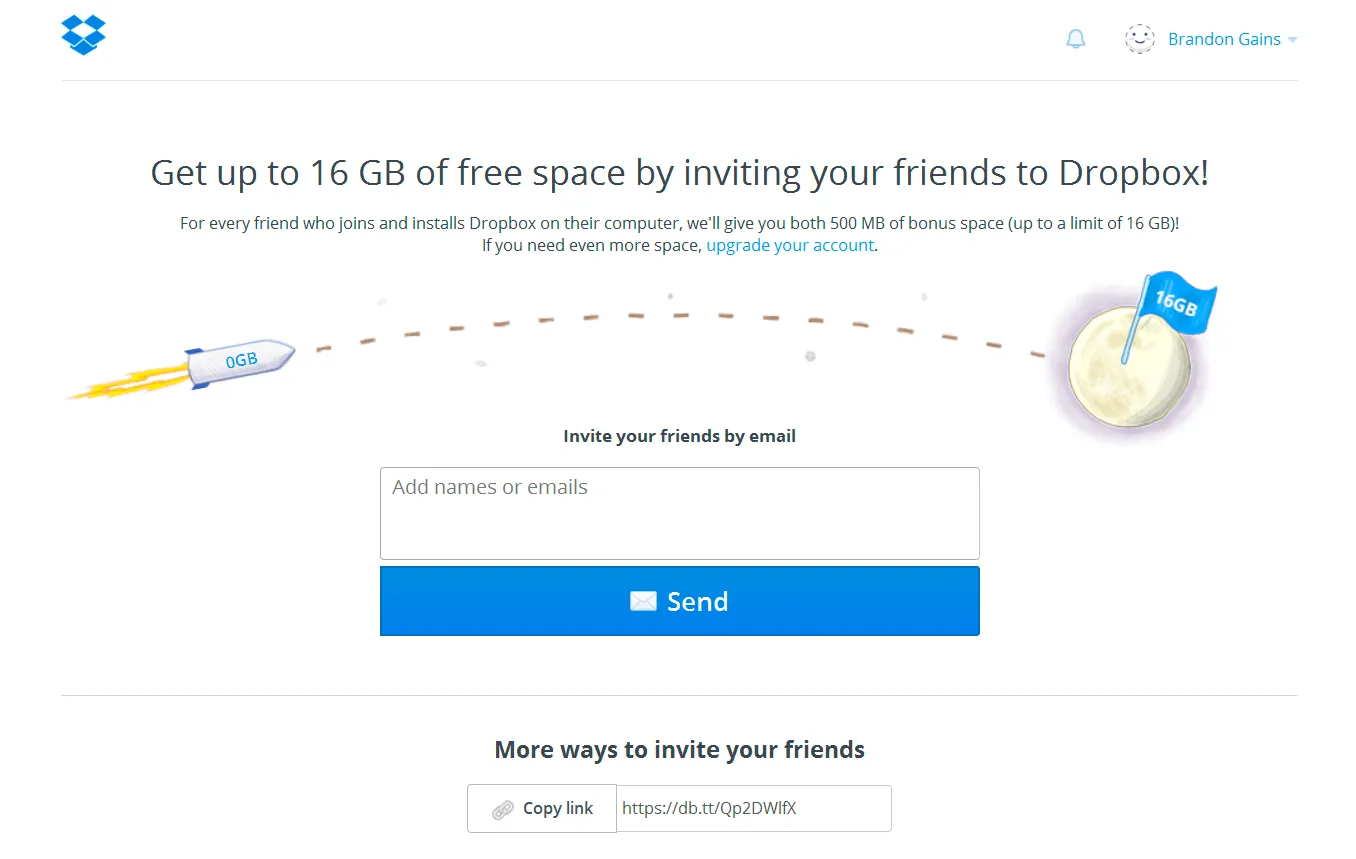
Initially, Dropbox incentivized both the referrer and the referee with 250MB of online storage space, which was quite significant in 2009. The simplicity of this offer and the immediate value it provided to users led to a high adoption rate.
Over time, Dropbox continued to tweak and optimize its referral program.
For instance, they made the referral process straightforward and prominently displayed the sharing options and rewards on the referral page. This user-friendly approach further fuelled user acquisition.
Today, Dropbox Basic accounts can earn up to 16GB through referrals, while Plus, Family, and Professional accounts can earn up to 32GB. The success of Dropbox's referral program underscores the importance of providing immediate, tangible value to users and maintaining a user-friendly referral process.
For a complete breakdown of Dropbox's referral program, visit this link.
You've got the lowdown: what they are, how to create one, and the pitfalls to dodge. Time to put that knowledge to work and kickstart your own referral program.
Lead with clarity, keep it seamless, and reward like a champ. Listen to your customers, adapt, and perfect.
And remember, when done right, a referral program isn't just a strategy—it's a growth multiplier. Ready to grow? Get started with your referral program through Viral Loops now.